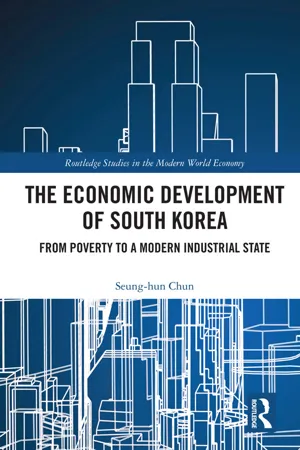
eBook - ePub
The Economic Development of South Korea
From Poverty to a Modern Industrial State
Seung-hun Chun
This is a test
- 274 páginas
- English
- ePUB (apto para móviles)
- Disponible en iOS y Android
eBook - ePub
The Economic Development of South Korea
From Poverty to a Modern Industrial State
Seung-hun Chun
Detalles del libro
Vista previa del libro
Índice
Citas
Información del libro
How did a country with a dearth of natural resources, a sprawling population congested in a limited arable land transform itself to a modern industrial state within a generation? How could these have been achieved given the lingering geopolitical threats to its very survival as a state, as evidenced by the Korean War and the internecine aggressive posturing of its neighbor from the north?
This book looks at strategies, institutional arrangement, role of entrepreneurs and workers in this odyssey, and on how those factors have worked together through effective leadership to transform South Korea's economic fortunes.
Preguntas frecuentes
¿Cómo cancelo mi suscripción?
¿Cómo descargo los libros?
Por el momento, todos nuestros libros ePub adaptables a dispositivos móviles se pueden descargar a través de la aplicación. La mayor parte de nuestros PDF también se puede descargar y ya estamos trabajando para que el resto también sea descargable. Obtén más información aquí.
¿En qué se diferencian los planes de precios?
Ambos planes te permiten acceder por completo a la biblioteca y a todas las funciones de Perlego. Las únicas diferencias son el precio y el período de suscripción: con el plan anual ahorrarás en torno a un 30 % en comparación con 12 meses de un plan mensual.
¿Qué es Perlego?
Somos un servicio de suscripción de libros de texto en línea que te permite acceder a toda una biblioteca en línea por menos de lo que cuesta un libro al mes. Con más de un millón de libros sobre más de 1000 categorías, ¡tenemos todo lo que necesitas! Obtén más información aquí.
¿Perlego ofrece la función de texto a voz?
Busca el símbolo de lectura en voz alta en tu próximo libro para ver si puedes escucharlo. La herramienta de lectura en voz alta lee el texto en voz alta por ti, resaltando el texto a medida que se lee. Puedes pausarla, acelerarla y ralentizarla. Obtén más información aquí.
¿Es The Economic Development of South Korea un PDF/ePUB en línea?
Sí, puedes acceder a The Economic Development of South Korea de Seung-hun Chun en formato PDF o ePUB, así como a otros libros populares de Économie y Théorie économique. Tenemos más de un millón de libros disponibles en nuestro catálogo para que explores.
Información
1 Korea from the trap of poverty to a modern industrial state
1 From hopelessness to the Miracle on the Han River
The defeat of Japan by the Allied Powers in 1945 saw the liberation of the Korean Peninsula from colonialism and the birth of the new nation, the Republic of Korea (hereinafter referred to as South Korea or Korea) in 1948. However, its birth was not without complications. Driven by competing geostrategic interests, the Soviet Union and the United States were soon to rush into taking controlling stakes of the liberated Korean Peninsula in 1945. The Soviets took control of the northern half and the Americans the southern half. During this period of occupation, nascent governments were being groomed along the ideological cleavages of their respective occupation forces. Both blocs eventually agreed to place Korea under a United Nations (UN) trusteeship, arguing that Koreans lacked the capacity for self-government. The proposal was, however, fiercely rejected in the southern half of the peninsula because of fears that it was the first step in a plot to place the peninsula into the Communist bloc. After initial opposition, the north was nudged by the Soviet Union into endorsing the proposal. A planned nationwide general election under the auspices of the United Nations was rejected by the North, and South Korea was born as the only legitimate government by the UN. The North declared another government, the Democratic People’s Republic of Korea (DPRK, hereinafter referred to as North Korea), supported by the Socialist bloc, the Soviet Union and China. Tip O’Neill, the late US congressman from Massachusetts, popularized the axiom “all politics is local.” Yet, the moral of local politics hardly ever matters in the realm of international politics, and none more so than the history of the brutal twentieth century. So it was that weak states were subordinated to vassals and allegiances transient in a crude worship of the morality of power.
The North soon launched an unprovoked attack against the South, backed up by its Socialist alliance of the Soviet Union and China in 1950 with the goal of unifying the entire peninsula under a single communist government. This triggered a response from the democratic bloc in defense of the South in what became the Korean War (1950–1953). The end of hostilities between the two halves was reached through an armistice that is still in force today. Geopolitically the newly born South Korea became an isolated island blocked to the north by a hostile Socialist regime and over the ocean confronted by the former colonial regime Japan with no diplomatic relations. Under the circumstances, South Korea had to struggle against serious poverty and military threats to survive.
Suffice it to look at the living conditions under which the citizens of the newly formed republic in the South lived in the immediate post-war era. Three main indicators may be used to measure a fair assessment of living conditions in a country: (1) international balance of payments, (2) gross domestic product (GDP) per capita and (3) life expectancy. The first indicates how much a country is financially sustainable; the second measures the average earnings of a country; and the third refers to the health status of the people. The following three figures give a sense of the long-term trend of these three indicators in Korea with international comparisons. For the sake of discussion, let us just focus our attention on the status of the early 1960s figures for the time being.
First, regarding international balance of payments, Korea was faced with serious trade deficits during the period under review, as Figure 1.1 shows. To making a living, at least in the long run, it is important to ensure that revenue or earnings exceed expenditures, and that holds true for households, corporations and countries. According to the same figure, Korea exported $33 million and imported $344 million worth of goods, making a deficit of $311 million in 1960. In fact, Korea was importing approximately ten times more than it was exporting. Meanwhile, the Philippines and Ghana were in much better position in this respect. It would thus be no surprise to learn that by this point the Korean economy was closer to the verge of bankruptcy than many developing countries until the 1960s.
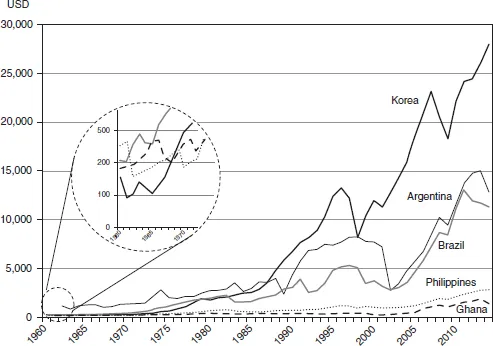
Figure 1.1 The trend of trade balance (in current USD), an international comparison
Source: Korea International Trade Association and World Bank national accounts data and OECD National Accounts data files
Looking into trade items is even more disappointing. Agricultural and fishery products constituted the bulk of South Korea’s exports, whereas import products were mainly foodstuffs, raw materials and intermediate goods, energy and chemical products – all essential goods for the livelihood of the citizens.1 The prospects for trade imbalance looked very bleak indeed.
Second, regarding income levels in Figure 1.2, Korea’s GDP per capita in 1960 was $156, lagging against Ghana and the Philippines. In many ways, it was the poster child of an underdeveloped and fragile state among the lowest income group of nations, according to the World Bank. Income levels were lower than that of most Asian countries, similar or lower than that of most African countries in those days, and much lower than many South American countries such as Brazil and Argentina.
Third, the low-income level is reflected in the low life expectancy of 53 years in 1960 shown in Figure 1.3, at a time when the average figure of the OECD (Organisation for Economic Co-operation and Development) member countries was 67.3 years. This confirms the general correlation between poverty and high mortality.
To avoid default, the deficits had to be compensated by either foreign aid or foreign loan. As Figure 1.4 shows, Korea was heavily dependent on foreign aid for subsistence. According to the figure, during the late 1950s foreign aid occupied almost half of the government’s revenue. Korea was financially unsustainable. Foreign aid was a lifeline to the poor Korean citizens in those days.
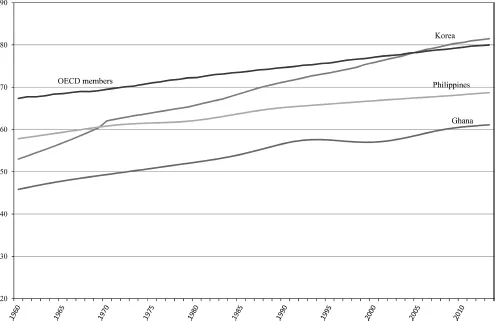
Figure 1.2 The trend of GDP per capita (in current USD), an international comparison
Source: World Bank national accounts data and OECD national accounts data files
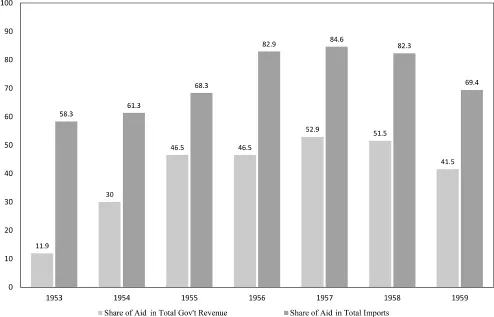
Figure 1.3 The trend of life expectancy in Korea
Source: World Bank DataBank – World Development Indicators
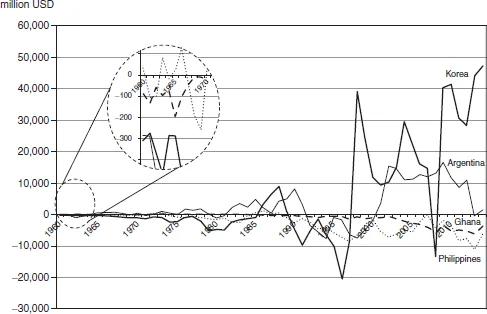
Figure 1.4 Foreign aid during 1950s in Korea
Source: Kim Jun-Kyung et al., 2011 Modularization of Korea’s Development Experience: Impact of Foreign Aid on Korea’s Development, (Seoul, Korea: MOSF and KDI school, 2012), 87
The miserable status of Korea was well witnessed by international experts and journals. After an inspection tour of war-torn Korea as part of the United Nations Korea Reconstruction Agency (UNKRA), the maverick Indian diplomat V. K. Krishna quipped, “will a rose blossom in a refuse bin?” An assessment of the South Korean economy by the government of Japan published in a report titled “On the Korean Economy” in July 1961 added to the scathing international consensus that South Korea was a literal basket case.2 A well-known scholar in Asian studies and senior consultant of USAID in the Asian region, David I. Steinberg (2001) argued in his comparison of Myanmar, Thailand and South Korea that Myanmar would be the potential economic and political leader, Thailand the second choice and South Korea not a contender among the three.3
Now let us turn our attention to the aforementioned three figures focusing on 2000s. Concerning the international balance of payments, the chronic deficit position that appeared almost impossible to deal with shows a stable position at an enormously enlarged scale. During the period of 1960 and 2014, exports jumped from $33 million to $573 billion and imports from $344 million to $526 billion, respectively, which resulted in a sharp switch from a deficit of $311 million to a surplus of $47 billion. Meanwhile, the Philippines and Ghana are suffering deficits of $6.6 billion and $3.7 billion, respectively. Looking at per capita income, GDP per capita in Korea surpassed the $20,000 mark in 2006. This marked the beginning of an aid-dependent country transforming into a donor country as a member of the OECD/DAC (Development Assistance Committee). Alongside the increased income, a corresponding increase in life expectancy was observed, far surpassing that of the Philippines and Ghana, and even the average of OECD member countries. This goes to confirm that the poverty reduction and economic development of Korea is not just empty rhetoric.
If as the axiom says, “a picture is worth a thousand words,” the pictures Seoul’s downtown Chong-gye stream show symbolically the remarkable transformation of living standards of citizens of Seoul and the Korean people during recent decades. The shabby houses in Seoul in the 1950s were completely reshaped in the 2000s, as the right-hand side picture illustrates. Its unprecedented rags-to-riches story has been dubbed the “The Miracle on the Han River,” as did Robert Lucas Jr. (1993):
I do not think it is in any way an exaggeration to refer to this continuing transformation of the Korean society as a miracle. . . . Never before have the lives of so many people undergone so rapid an improvement over so long a period, nor is there any sign that this progress is near its end.4
At the heart of the significant increase in the nation’s output and income was the result of a sustained growth in the industrial base. Korea has grown as an international manufacturing hub in steel, electronic goods, automobile, shipbuilding and machinery goods, which supports an enormous growth of exports and thus surplus in the international balance of payments. This industrial performance is particularly appreciated in several respects by the international community.
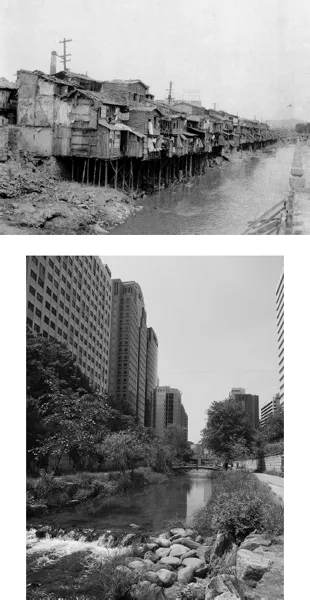
Picture 1.1 The feature of Chong-gye stream downtown Seoul: in 1950s (top) and in 2000s (bottom)
©Seoul Museum of History Digital Archive
www.museum.seoul.kr/www/theme/NR_themeMuseumView.do?arcvNo=65301&arcvMetaSeq=21243&langGubun=01&groupNo2=341&sso=ok)
First, full industrialization in Korea was attained in a country that has an insufficient domestic market. To fully develop the heavy and chemical industries (HCI) such as steel, automobile, shipbuilding and petrochemicals, the market should be large enough to accommodate them. In Korea’s case, here was a population of 35 million when full-scale industrialization policies were launched. Second, the pace of the industrialization is also quite breathtaking. As will be discussed in Sections 5.1 and 7.3, industrialization in Korea has proceeded much faster than in Western Europe and Japan. This may be accountable to either reduced learning costs by being a late starter for industrialization, a more efficient industrial policy in Korea or both of these.
2 The start of the urge
To understand the great transformation of the South Korean economy, we need to analyze both the initial conditions for development and the corresponding development strategies based on the initial conditions of the economy. First, the country had a population of 25 million in 1960 that was growing at 3 percent per annum, partly due to a huge southbound migration from the North after the partition of the peninsula. With a territorial mass of 98,431 square kilometers, there was a population density of 254 persons per square kilometer....
Índice
- Cover
- Title
- Copyright
- Dedication
- Contents
- List of figures
- List of pictures
- Preface
- Acknowledgments
- 1 Korea from the trap of poverty to a modern industrial state
- 2 The travails of state building and institutional arrangement for development
- 3 Transforming the social and environmental landscape
- 4 Impact for export and job creation
- 5 Path to industrialization (1): paving the way to industrialization
- 6 The advent of industrial titans
- 7 Path to industrialization (2): heavy and chemical industries push the needle
- 8 Development of human resources and technology
- 9 Attracting foreign capital to spark development
- 10 Saemaul Undong: Korea’s new deal for rural modernization
- 11 The people and state-community on a track of economic development
- Epilogue: path to development under globalization
- Bibliography
- Index
Estilos de citas para The Economic Development of South Korea
APA 6 Citation
Chun, S. (2018). The Economic Development of South Korea (1st ed.). Taylor and Francis. Retrieved from https://www.perlego.com/book/1379896/the-economic-development-of-south-korea-from-poverty-to-a-modern-industrial-state-pdf (Original work published 2018)
Chicago Citation
Chun, Seung-hun. (2018) 2018. The Economic Development of South Korea. 1st ed. Taylor and Francis. https://www.perlego.com/book/1379896/the-economic-development-of-south-korea-from-poverty-to-a-modern-industrial-state-pdf.
Harvard Citation
Chun, S. (2018) The Economic Development of South Korea. 1st edn. Taylor and Francis. Available at: https://www.perlego.com/book/1379896/the-economic-development-of-south-korea-from-poverty-to-a-modern-industrial-state-pdf (Accessed: 14 October 2022).
MLA 7 Citation
Chun, Seung-hun. The Economic Development of South Korea. 1st ed. Taylor and Francis, 2018. Web. 14 Oct. 2022.